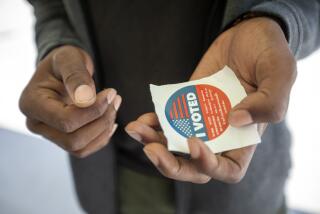An Internet E-Ballot for Democracy
- Share via
Neither Valley secession, as advocated by Valley VOTE, nor approval of a new city charter, as recommended by the two charter reform commissions, would do much to improve the way we govern ourselves in Los Angeles because neither would fundamentally change the way we choose our officials and policies.
E-voting, by which citizens could sign initiative petitions and vote in elections over the Internet, is feasible now and offers a cost-effective, elegant means of achieving this democratic empowerment.
How would e-voting work in Los Angeles?
Using their own computers at home or work, or public computers in schools, libraries, kiosks in malls and elsewhere, registered voters would use a digital certificate--a unique electronic identification number--along with an election-specific password, to authenticate themselves at the Web site of an electronic election system. The process would work much the way we now use a credit card number and expiration date to authenticate ourselves to online or brick-and-mortar merchants.
Once authenticated, voters could access a personalized electronic ballot--an “e-ballot”--containing lists of candidates, initiatives and referendums specific to their district. Using a mouse or other pointing device, voters would make choices by clicking next to candidate names or next to “yes” or “no” for ballot measures.
At the end of the process, choices would be displayed for confirmation and the voter would click on a “submit” icon to send the e-ballot to a secure electoral server. There the voter’s name would be taken off the list of those still eligible to cast ballots in that election and the contents of the e-ballot would be severed from identification. The now-anonymous e-ballot would be aggregated with all the others for counting and reporting to election authorities, the media and public, over the Internet, of course.
Having an electronic election system running over the Internet would mean lower costs for election administrators and, therefore, for us as taxpayers, and increased security and audit capability for ballots. Above all, it would mean more voter convenience and higher turnout (maybe soon to be known as “stayin”) and a more representative election.
Having an electronic election system in place would also make it much easier for the physically challenged to vote. Having it in place right now would mean that it could be used for voting on charter reform and secession. It could be used to collect signatures on municipal initiative petitions, as well as for elections to select neighborhood councils. It would allow for frequent initiatives and referendums within neighborhoods, council districts or the entire city.
Were such a system in place, it might eliminate the need to spend $270,000 to check thousands of Valley VOTE (Voters Organized Toward Empowerment) petition signatures by hand, and it would mean that the process would take minutes, not months.
*
Not everyone owns a computer. But having an electronic election system in place would be a stimulus to work even harder--through public and private means--to provide every person with the access and training to enable him or her to participate fully, as a citizen, student and worker, in the electronic life of the next century, including the political life.
Instead of not having the time to vote in our busy days, why don’t we decide now to make our political lives easier by giving ourselves and all other eligible citizens the right to vote over the Internet?
Like cell phones, nonexistent 20 years ago and ubiquitous today, e-voting could become another way we routinely use technology, individually and collectively, to create a little more order and justice.
More to Read
Get the L.A. Times Politics newsletter
Deeply reported insights into legislation, politics and policy from Sacramento, Washington and beyond. In your inbox three times per week.
You may occasionally receive promotional content from the Los Angeles Times.










